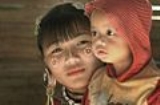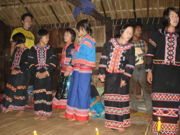
Lahu people
Encyclopedia
The Lahu are an ethnic group
of Southeast Asia
and China
.
They are one of the 56 ethnic groups officially recognized by the People's Republic of China
, where about 450,000 live in Yunnan
province. An estimated 150,000 live in Burma. In Thailand
, Lahu are one of the six main hill tribes; their population is estimated at around 100,000. The Tai
often refer to them by the exonym "Mussur" or hunter. About 10,000 live in Laos
. They are one of 54 ethnic groups in Vietnam
, where about 1,500 live in Lai Chau province.
The Lahu population outside of Asia is extremely small. In the United States
, the Lahu populace is most likely found in the states of Minnesota, California and North Carolina.
 The Lahu divide themselves into a number of subgroups, such as the Lahu Na (Black Lahu), Lahu Nyi (Red Lahu), Lahu Hpu (White Lahu), Lahu Shi (Yellow Lahu) and the Lahu Shehleh. Where a subgroup name refers to a color, it refers to the traditional color of their dress. These groups do not function as tribe
The Lahu divide themselves into a number of subgroups, such as the Lahu Na (Black Lahu), Lahu Nyi (Red Lahu), Lahu Hpu (White Lahu), Lahu Shi (Yellow Lahu) and the Lahu Shehleh. Where a subgroup name refers to a color, it refers to the traditional color of their dress. These groups do not function as tribe
s or clan
s - there are no kin groups above that of the family. Lahu trace descent bilaterally, and typically practice matrilocal residence
.
branch of the Lolo–Burmese subgroup of the Tibeto-Burman
family (itself a member of the Sino-Tibetan language family). Like most of its relatives, it is a heavily isolating language
with subject–object–verb word order, and a set of numeral classifiers
. There are seven tones
, and consonants cannot close syllables. The language spoken by the Lahu Shi is notably divergent from that spoken by the other groups. In Thailand, Lahu Na often serves as a lingua franca
among the various hill tribes. Written Lahu uses the Latin alphabet
. Among Christian
villages, the language has been enriched by loanwords from English
, Latin
and Greek
via Bible translation, plus neologisms in the areas of hygiene, music and education.
was introduced in the late 17th century and became widespread. Many Lahu in China are Christians. Christianity became established in Burma in the 19th century and has been spreading since.
The Lahu of Northeastern Thailand had encounters with Theravada Buddhist forest monks (tudong monks) around the years 1930-1940. The leader of such a group of monks, ajahn Man (or Mun), spent some time in Lahu territory. These Lahu asked him for a "gatha that would protect them from ghosts and demons." The word "gatha", song or verse, is most used in Mahayana Buddhism. Hence this episode shows that Mahayana Buddhist monks preceded the Theravada monks in this particular area.
Ethnic group
An ethnic group is a group of people whose members identify with each other, through a common heritage, often consisting of a common language, a common culture and/or an ideology that stresses common ancestry or endogamy...
of Southeast Asia
Southeast Asia
Southeast Asia, South-East Asia, South East Asia or Southeastern Asia is a subregion of Asia, consisting of the countries that are geographically south of China, east of India, west of New Guinea and north of Australia. The region lies on the intersection of geological plates, with heavy seismic...
and China
China
Chinese civilization may refer to:* China for more general discussion of the country.* Chinese culture* Greater China, the transnational community of ethnic Chinese.* History of China* Sinosphere, the area historically affected by Chinese culture...
.
They are one of the 56 ethnic groups officially recognized by the People's Republic of China
People's Republic of China
China , officially the People's Republic of China , is the most populous country in the world, with over 1.3 billion citizens. Located in East Asia, the country covers approximately 9.6 million square kilometres...
, where about 450,000 live in Yunnan
Yunnan
Yunnan is a province of the People's Republic of China, located in the far southwest of the country spanning approximately and with a population of 45.7 million . The capital of the province is Kunming. The province borders Burma, Laos, and Vietnam.Yunnan is situated in a mountainous area, with...
province. An estimated 150,000 live in Burma. In Thailand
Thailand
Thailand , officially the Kingdom of Thailand , formerly known as Siam , is a country located at the centre of the Indochina peninsula and Southeast Asia. It is bordered to the north by Burma and Laos, to the east by Laos and Cambodia, to the south by the Gulf of Thailand and Malaysia, and to the...
, Lahu are one of the six main hill tribes; their population is estimated at around 100,000. The Tai
Tai languages
The Tai or Zhuang–Tai languages are a branch of the Tai–Kadai language family. The Tai languages include the most widely spoken of the Tai–Kadai languages, including standard Thai or Siamese, the national language of Thailand; Lao or Laotian, the national language of Laos; Burma's Shan language;...
often refer to them by the exonym "Mussur" or hunter. About 10,000 live in Laos
Laos
Laos Lao: ສາທາລະນະລັດ ປະຊາທິປະໄຕ ປະຊາຊົນລາວ Sathalanalat Paxathipatai Paxaxon Lao, officially the Lao People's Democratic Republic, is a landlocked country in Southeast Asia, bordered by Burma and China to the northwest, Vietnam to the east, Cambodia to the south and Thailand to the west...
. They are one of 54 ethnic groups in Vietnam
Vietnam
Vietnam – sometimes spelled Viet Nam , officially the Socialist Republic of Vietnam – is the easternmost country on the Indochina Peninsula in Southeast Asia. It is bordered by China to the north, Laos to the northwest, Cambodia to the southwest, and the South China Sea –...
, where about 1,500 live in Lai Chau province.
The Lahu population outside of Asia is extremely small. In the United States
United States
The United States of America is a federal constitutional republic comprising fifty states and a federal district...
, the Lahu populace is most likely found in the states of Minnesota, California and North Carolina.
Subgroups

Tribe
A tribe, viewed historically or developmentally, consists of a social group existing before the development of, or outside of, states.Many anthropologists use the term tribal society to refer to societies organized largely on the basis of kinship, especially corporate descent groups .Some theorists...
s or clan
Clan
A clan is a group of people united by actual or perceived kinship and descent. Even if lineage details are unknown, clan members may be organized around a founding member or apical ancestor. The kinship-based bonds may be symbolical, whereby the clan shares a "stipulated" common ancestor that is a...
s - there are no kin groups above that of the family. Lahu trace descent bilaterally, and typically practice matrilocal residence
Kinship terminology
Kinship terminology refers to the various systems used in languages to refer to the persons to whom an individual is related through kinship. Different societies classify kinship relations differently and therefore use different systems of kinship terminology - for example some languages...
.
Language
The Lahu language is part of the LoloishLoloish languages
The Loloish languages, also known as Ngwi or in China as Yi, are a family of fifty to a hundred languages of the Tibeto-Burman language family. They are most closely related to Burmese and its relatives. Both the Loloish and Burmish branches are well defined, as is their superior node, Lolo–Burmese...
branch of the Lolo–Burmese subgroup of the Tibeto-Burman
Tibeto-Burman languages
The Tibeto-Burman languages are the non-Chinese members of the Sino-Tibetan language family, over 400 of which are spoken thoughout the highlands of southeast Asia, as well as lowland areas in Burma ....
family (itself a member of the Sino-Tibetan language family). Like most of its relatives, it is a heavily isolating language
Isolating language
An isolating language is a type of language with a low morpheme-per-word ratio — in the extreme case of an isolating language words are composed of a single morpheme...
with subject–object–verb word order, and a set of numeral classifiers
Measure word
In linguistics, measure words are words that are used in combination with a numeral to indicate an amount of some noun. They denote a unit or measurement and are used with nouns that are not countable. For instance, in English, is a mass noun and thus one cannot say *"three muds", but one can say...
. There are seven tones
Tone (linguistics)
Tone is the use of pitch in language to distinguish lexical or grammatical meaning—that is, to distinguish or inflect words. All verbal languages use pitch to express emotional and other paralinguistic information, and to convey emphasis, contrast, and other such features in what is called...
, and consonants cannot close syllables. The language spoken by the Lahu Shi is notably divergent from that spoken by the other groups. In Thailand, Lahu Na often serves as a lingua franca
Lingua franca
A lingua franca is a language systematically used to make communication possible between people not sharing a mother tongue, in particular when it is a third language, distinct from both mother tongues.-Characteristics:"Lingua franca" is a functionally defined term, independent of the linguistic...
among the various hill tribes. Written Lahu uses the Latin alphabet
Latin alphabet
The Latin alphabet, also called the Roman alphabet, is the most recognized alphabet used in the world today. It evolved from a western variety of the Greek alphabet called the Cumaean alphabet, which was adopted and modified by the Etruscans who ruled early Rome...
. Among Christian
Christian
A Christian is a person who adheres to Christianity, an Abrahamic, monotheistic religion based on the life and teachings of Jesus of Nazareth as recorded in the Canonical gospels and the letters of the New Testament...
villages, the language has been enriched by loanwords from English
English language
English is a West Germanic language that arose in the Anglo-Saxon kingdoms of England and spread into what was to become south-east Scotland under the influence of the Anglian medieval kingdom of Northumbria...
, Latin
Latin
Latin is an Italic language originally spoken in Latium and Ancient Rome. It, along with most European languages, is a descendant of the ancient Proto-Indo-European language. Although it is considered a dead language, a number of scholars and members of the Christian clergy speak it fluently, and...
and Greek
Greek language
Greek is an independent branch of the Indo-European family of languages. Native to the southern Balkans, it has the longest documented history of any Indo-European language, spanning 34 centuries of written records. Its writing system has been the Greek alphabet for the majority of its history;...
via Bible translation, plus neologisms in the areas of hygiene, music and education.
Religion
The traditional Lahu religion is polytheistic. BuddhismBuddhism
Buddhism is a religion and philosophy encompassing a variety of traditions, beliefs and practices, largely based on teachings attributed to Siddhartha Gautama, commonly known as the Buddha . The Buddha lived and taught in the northeastern Indian subcontinent some time between the 6th and 4th...
was introduced in the late 17th century and became widespread. Many Lahu in China are Christians. Christianity became established in Burma in the 19th century and has been spreading since.
The Lahu of Northeastern Thailand had encounters with Theravada Buddhist forest monks (tudong monks) around the years 1930-1940. The leader of such a group of monks, ajahn Man (or Mun), spent some time in Lahu territory. These Lahu asked him for a "gatha that would protect them from ghosts and demons." The word "gatha", song or verse, is most used in Mahayana Buddhism. Hence this episode shows that Mahayana Buddhist monks preceded the Theravada monks in this particular area.

